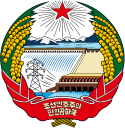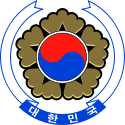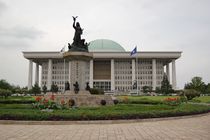Korean reunification
| Korean reunification | |
|---|---|
 Unification Flag of Korea |
|
| Korean name | |
| Hangul | 조국통일 |
| Hanja | 祖國統一 |
| Revised Romanization | Joguk Tong(-)il |
| McCune–Reischauer | Choguk T'ongil |
Korean reunification (Korean: 조국통일, also called 남북통일 (in the South, literally South-North Reunification) and 북남통일 (in the North, literally North-South Reunification)) refers to the hypothetical future reunification of North Korea and South Korea under a single government. The process towards this was started by the historic June 15th North-South Joint Declaration in August 2000, where the two countries agreed to work towards a peaceful reunification in the future.
However, there are a number of hurdles in this process due to the large political and economic differences between the two countries and other state actors such as China, Russia, the United States and Japan. Short-term problems such as a large number of refugees from the North migrating into the South and initial economic and political instability would need to be overcome. Long-term problems such as cultural differences, contrasting political ideologies and possible discrimination will also need to be resolved.
Contents |
Division
|
|||||||||||||
|
Japan annexed Korea in 1910 and ruled over it until 1945. After Japan's defeat in World War II, the United Nations developed plans for trusteeship administration of Korea.
The 38th parallel divided the peninsula into two zones of administration: the Soviet Union to the north and the United States to the south. Cold War politics resulted in the 1948 establishment of two separate governments. In June 1950, North Korea invaded South Korea, beginning the Korean War. After three devastating years of fighting that involved the People's Republic of China, the Soviet Union, and the United Nations led by the U.S., the war ended in a ceasefire agreement at approximately the same boundary, with South Korea making slight territorial gains. The two countries never signed a peace treaty.
Despite now being politically separate entities, both governments proclaim as a goal the eventual restoration of Korea as a single state. A unified Korea is a very important component of Korean national identity. A unified Korean team marched in the opening ceremonies of the 2000 Summer Olympics in Sydney, 2004 Summer Olympics in Athens, and the 2006 Winter Olympics in Turin, but the North and South Korean national teams competed separately. There were plans for a truly unified team at the 2008 Summer Olympics in Beijing, China, but they were unable to agree on the details of its implementation. In the 1991 table tennis world championships in Chiba, Japan, the two countries formed a unified team.
Current status
Eventual political integration of the Koreas under a democratic government from the South is generally viewed as inevitable by all parties involved, except North Korea. However, the nature of unification, i.e. through North Korean collapse or gradual integration of the North and South, is still a topic of intense political debate and even conflict among interested parties, who include both Koreas, China, Japan, Russia, and the United States.
Some political analysts and many Koreans would say the process of reunification has already begun,[1] albeit at a very gradual pace, through the current process of reconciliation and economic cooperation between the two Koreas. On the other hand, current reality would seem to show otherwise, as the DMZ that separates the two Koreas remains heavily guarded and North Korea has yet to give up its nuclear weapons.
Summits and General Assembly meetings
Following a summit meeting in Pyongyang from 13 to 15 June 2000 between the leaders of the two countries, the chairpersons of the Millennium Summit issued a statement welcoming their Joint Declaration as a breakthrough in bringing peace, stability and reunification to the Korean peninsula.[2] Seven weeks later a resolution to the same effect passed by the United Nations General Assembly after being co-sponsored by 150 other nations.[3]
A scheduled General Assembly debate on the topic in 2002 was deferred for a year at the request of both nations,[4] and when the subject returned in 2003 it was immediately dropped off the agenda.[5]
The issue did not return to the General Assembly until 2007,[6] following a second inter-Korean summit held in Pyongyang from 2 to 4 October 2007. These talks were held during one the round of the Six-Party Talks in Beijing which committed to the denuclearization of the Korean peninsula.[7]
Reunification strategies
The "Sunshine Policy"
Supporters of the "Sunshine Policy" argue that sanctions and threats from the governments of the United States and South Korea have harmed, rather than improved, prospects for reunification. They argue that if the North Korean government does not feel threatened by South Korea or the United States, it will have nothing to lose and everything to gain from dialogue and engagement with the outside world, and will have no reason to build weapons of mass destruction. Many argue that the only alternative to dialogue is an unacceptable military outcome. The Sunshine Policy was introduced by the Millennium Democratic Party under President Kim Dae-jung, and was continued by President Roh Mu-hyun. South Korea's Hyundai Asan played a major role in pioneering commercial links with the North.
Korean Economic Community
It has recently been suggested that the formation of a Korean Economic Community could be a way to ease in unification of the Korean peninsula.[8] Lee Myung-bak departing from the Grand National Party's traditional hardline stance has outlined a comprehensive diplomatic package on North Korea that includes setting up a consultative body to discuss economic projects between the two Koreas. He proposed seeking a Korean economic community agreement to provide the legal and systemic basis for any projects agreed to in the body.[9]
A pragmatic policy
Opponents of the "Sunshine Policy" argue that dialogue and trade with North Korea has done nothing to improve prospects for peaceful reunification, and have helped bolster the North Korean government, which is corrupt, undemocratic, and totalitarian. They feel that the North has no real interest in reunification, and is only trying to ensure its own survival.
It is also argued that South Korea has seen little benefit from engagement with North Korea, despite the transfer of large funds to the North Korean government by President Kim Dae-jung. Many also believe South Korea should remain prepared in the event of a North Korean attack. The Grand National Party is in favour of a hard-line position on North Korea. Hard-line policy supporters also argue that the help given to North Korea only continues the regime of Kim Jong-Il and that leaving it alone will eventually bring the collapse of North Korea, thus allowing the country to be reunified under the Republic of Korea.
In 2003, South Korean Unification Church members started a political party named "The Party for God, Peace, Unification, and Home." In an inauguration declaration, the new party said it would focus on preparing for the reunification of the South and North Korea by educating the public about God and peace. A church official said that similar political parties would be started in Japan and the United States.[10]
North Korea's policy
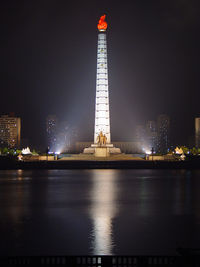
North Korea's policy is to seek reunification without what it sees as outside interference, through a federal structure retaining each side's leadership and systems. Both North and South Korea signed the June 15th North-South Joint Declaration in which both sides made promises to seek out a peaceful reunification.[11]
In 1973, North Korea proposed forming a Confederal Republic of Koryo that would represent Korean people in the UN[12]. The North Korean President Kim Il Sung elaborated on the proposed state (then called Democratic Confederal Republic of Koryo[13]) on October 10, 1980 in the Report to the Sixth Congress of the Worker's Party of Korea on the Work of the Central Committee. Kim proposed a federation between North and South Korea in which the respective political systems would initially remain.[14]
International views
United States: The United States officially supports Korean reunification under a democratic government.
China: The Chinese government officially supports reunification under peaceful means.
Japan: The Japanese government has expressed its support for eventual reunification of the two Koreas under a democratic government. Still, the current state of Japanese abductees by North Korea continues to be an issue with the Japanese.
Russia: Since 2000, Russia has expressed hopes for continued stability of the Korean Peninsula but tends to maintain the status quo is more in line Russian policy.
Hurdles in the process
Culture
The cultures of the two halves have diverged following partition, even though traditional Korean culture and history are shared. In addition, many families have been split by the division of Korea. In the roughly comparable situation of the German reunification, the 38-year-long separation has left significant impacts on German culture and society, even after almost two decades. Given the extreme differences of North and South Korean culture and lifestyle, the effects might last even longer. Many Germans believe that the difference between "Westerners" and "Easterners" will remain "as long as anyone lives who can remember the separation", though these cultural differences are almost non-existent between young people born after or shortly before the reunification. Therefore it is highly likely that the Korean youth will play a major role in the cultural integration after a Korean Reunification.
Economy
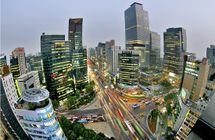
.jpg)
Economic differences between North and South Korea also are a cause of concern. Korean reunification would differ from the German reunification precedent:
- In relative terms, North Korea's economy is currently worse than that of East Germany was in 1990. The income per capita ratio (PPP) was about 3:1 in Germany (US$25,000 for West, about US$8,500 for East).[16][17] The ratio is about 15:1 in Korea (US$27,100 for South, US$1,800 for North),[18] although GDP estimates vary widely (see List of countries by GDP (PPP) per capita). This income gap is rapidly increasing as the North Korean economy stagnates and the South Korean economy is characterized by moderate to high economic growth.
- While at the moment of the German reunification the East German population (around 17,000,000) was about a third of the West German (more than 60,000,000), the North Korean population (around 22,700,000) is currently around a half of the South Korean (around 48,600,000).
- The North Korean population is far more culturally distinct and isolated than the East German population was in the late 1980s. Unlike in East Germany, North Koreans generally cannot receive foreign broadcasting or read foreign publications. Germany was divided for 44 years, whereas the Koreas have been divided for over 60, and have been technically at war for most of that period.
- The German economy still suffers (over twenty years later) from rapid reunification, with the former West Germany heavily subsidizing the former East. In addition, some analysts warn that rapid reunification might bring the South Korean economy to the point of collapse. It would also bring a flood of refugees into South Korea, China, and other countries, causing a social and economic crisis.
The consequence of the economic differences is that many South Koreans, while desiring reunification in theory, want to delay the process of reunification until the Northern economy can be developed separately, having seen the results of the sudden reunification of West Germany and East Germany, and knowing the differences between the two Koreas.
Politics and ideology
Currently, political issues such as diametrically opposite forms of government cause most concern. Nevertheless, the attitude of the South Korean government towards North Korea has changed dramatically in the last few decades; during the Park Chung-hee administration, hatred towards the North Korean government was fostered in the civilian population. For example, a poster displaying two Korean characters (반공 /Ban-gong; 反共) meaning "Against Communism" or "Anti Communism" was posted on every schoolhouse wall. In contrast, a recent comic book published by a South Korean author detailing a less-than-flattering portrait of the North Korean leader Kim Jong-il was banned because the South Korean government feared that its publication could hurt reunification efforts. In the North, the Korean Central News Agency often refers to the South Korean government as a "puppet government",[19][20] which in the opinion of North Korean leadership is the real obstacle to reunification. An 'Anti-Imperialist National Democratic Front' is a South Korean pro-DPRK organization that mostly operates from the North and aims at reunification from the DPRK perspective.
In popular culture
The issue of Korean reunification was a central or implied theme in several productions, mostly South Korean:
- The 2005 film Cheon gun (천군; 天軍) or "Heaven's Soldiers", directed by Min Joon Gi, portrayed North and South Korean soldiers who travel in time to 1572 and join the 16th century hero Yi Sun-sin in fighting the Jurchen tribes. This theme clearly uses the figure of Yi, venerated as a National Hero in both parts of contemporary Korea, to plead for reunification.
- Yesterday (예스터데이) is a 2002 film set in 2020 in a unified Korea.
- 2009 Lost Memories, a 2002 film, the backstory of which had a reunified Korea in the year 2008.
- Shiri (쉬리), a 1999 blockbuster has its male lead describing how the waters from both North and South Korea flow freely together, and how the fish called Shiri can be found in either water without knowing which it belongs to. It was the first major-release film to directly address the issue of Korean reunification.
- The 2005 film A Bold Family (Gan-keun gajok) was a comedy/drama that portrayed a South Korean family who stages a reunification in an attempt to be written into their dying father's will. Directed by Myeong-nam Jo.
- In the video game Homefront Korea is reunited under North Korean rule in 2015.[21]
See also
- Division of Korea
- List of Korea-related topics
- Chinese reunification
- Cypriot reunification
- German reunification
- Romanian reunification
References
- ↑ "Korea's slow-motion reunification". Boston Globe. June 9, 2005. http://www.boston.com/news/globe/editorial_opinion/oped/articles/2005/06/09/koreas_slow_motion_reunification/. Retrieved 2007-08-13.
- ↑ United Nations General Assembly Verbotim Report meeting 4 session 55 Statement by the Co-Chairpersons - Millennium Summit page 1 on 6 September 2000
- ↑ United Nations General Assembly Verbotim Report meeting 45 session 55 page 14 on 31 October 2000 (retrieved 2008-04-06)
- ↑ United Nations General Assembly Verbotim Report meeting 111 session 56 page 2 on 6 September 2002 (retrieved 2008-04-06)
- ↑ United Nations General Assembly Verbotim Report meeting 94 session 57 page 7 on 15 September 2003 (retrieved 2008-04-06)
- ↑ United Nations General Assembly Verbotim Report meeting 41 session 62 Peace, security and reunification on the Korean peninsula page 1 on 31 October 2007
- ↑ United Nations General Assembly Verbotim Report meeting 41 session 62 page 1, Mr. Choi Young-jin Republic of Korea on 31 October 2007 (retrieved 2008-04-06)
- ↑ Hong Soon-Jik (2007-08-26). "Toward reunification via inter-Korean economic community". Korea.net. http://www.korea.net/news/News/newsView.asp?serial_no=20070824029. Retrieved 2007-12-06.
- ↑ The Chosun Ilbo, Lee Myung-bak Unveils Inter-Korean Cooperation Plans 2007-09-11. Retrieved on 2007-12-06.
- ↑ 'Moonies' launch political party in S Korea,The Independent (South Africa), March 10, 2003
- ↑ "Naenara"-Korea is One-Leader and Nation-June 15 North-South Joint Declaration
- ↑ http://books.google.com/books?id=dB_8L4ysZrEC&pg=PA67&lpg=PA67&dq=koryo+confederal+republic&source=bl&ots=UgKAyvQ9tw&sig=c9HvyLly6tWrikdE_mCtnKdObws&hl=en&ei=WevASrT3HNLZ-QaF3pjFAQ&sa=X&oi=book_result&ct=result&resnum=8#v=onepage&q=koryo%20confederal%20republic&f=false
- ↑ http://books.google.com/books?id=Rq8Bq7xQZE0C&pg=PA128&lpg=PA128&dq=koryo+confederal+republic&source=bl&ots=zRTZQEBMkH&sig=BxfYldoe7lQjE3MekOQnyj7HTgU&hl=en&ei=WevASrT3HNLZ-QaF3pjFAQ&sa=X&oi=book_result&ct=result&resnum=6#v=onepage&q=koryo%20confederal%20republic&f=false
- ↑ http://www.geocities.com/songunpoliticsstudygroup/Oct102008/W-801010.HTM Let us Reunify the Country Independently and Peacefully, section of the Report discussing the DFRK
- ↑ http://www.citymayors.com/economics/financial-cities.html
- ↑ http://web.lexis-nexis.com/universe/docum5a3&_md5=1d29c9a57e02af0c782e122762a6b939
- ↑ Sliefer, Jaap. "Planning Ahead and Falling Behind. the East German Economy in Comparison with West Germany 1936–2002." 13 Sept. 2007. International Conference of Labour and Social History. <http://www.ith.or.at/ith_e/kuczynski_prize_lectures_2007_e.htm>.
- ↑ https://www.cia.gov/library/publications/the-world-factbook/rankorder/2004rank.html
- ↑ http://www.kcna.co.jp/item/1997/9701/news1/26.htm
- ↑ http://www.kcna.co.jp/item/2008/200807/news07/03.htm
- ↑ "E3 2010: Backstory Trailer HD". GameTrailers.com. http://www.gametrailers.com/video/e3-2010-homefront/101160. Retrieved 11 June 2010.
External links
- Ministry of Unification (South Korea)
- Article from DPRK Studies
- Korean Unification Studies
- Tongil Korea Net (Selected News and Opinions on Korean Reunification Issues)
|
|||||
